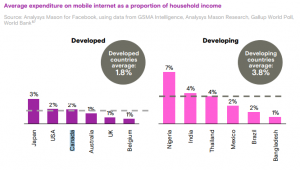Facebook and Analysys Mason released a report on the “State of Connectivity 2015” [pdf], that should be considered prerequisite reading material for those participating (and adjudicating) the upcoming CRTC Review of basic telecommunications services.
The four key barriers to internet access include:
- Availability: Proximity of the necessary infrastructure required for access.
- Affordability: The cost of access relative to income.
- Relevance: A reason for access, such as primary language content.
- Readiness: The capacity to access, including skills, awareness and cultural acceptance.
These barriers do not arise in isolation, nor can they be addressed in isolation. They function as a cluster, each one affecting the others. Unless corporations, government, NGOs and non-profits work together to address these chief barriers to access, the digital divide will persist and expand.
 Despite Canada’s expansive geography, service providers have been able to tackle the challenge of “Availability”. At The 2015 Canadian Telecom Summit, Allison Lenehan of Xplornet spoke of increases in speeds being made possible by his company and he challenged the Canadian industry to set a goal of 100 Mbps service to be available to all Canadians.
Despite Canada’s expansive geography, service providers have been able to tackle the challenge of “Availability”. At The 2015 Canadian Telecom Summit, Allison Lenehan of Xplornet spoke of increases in speeds being made possible by his company and he challenged the Canadian industry to set a goal of 100 Mbps service to be available to all Canadians.
The general affordability of mobile broadband in Canada was highlighted in a chart looking at “Average expenditure on mobile internet as a proportion of household income”, noting that this “does not account for all the variables that affect affordability, but it enables an approximation of the percentage of people who can reasonably afford internet services.”
As we plan initiatives to assist with affordability (a subject I have raised frequently), the report observes “Innovations that have the potential to significantly improve affordability, particularly at the bottom of the income distribution, are by nature risky. Given the very low amounts of money that individuals can commit, operators and other innovators must carefully plan and implement new tariffs or business models, to balance effectiveness with financial sustainability.”
Availability and affordability are just 2 of the 4 factors. The report says that for internet content and services to be relevant, they must be: Useful, Relatable and Accessible. Do content and services bring value to people, economically or otherwise? Is content compatible with individuals’ interests and culture, and services meet local needs? Beyond word-of-mouth, advertising and promotion, do platforms and devices enable people to find relevant content and share it easily?
Finally, individuals must be ‘ready’ to use the internet, implying: they have the skills to find and consume content, including language literacy (the ability to read and write) and digital literacy (the ability to use connected devices and the internet); they have an awareness and understanding of the internet and the benefits of being online; and, there needs to be a cultural or social acceptance of using the internet, a factor that the report claims particularly affects women, and is linked to attitudes about their education and empowerment. “Many people who can read and write lack the digital skills or a sufficient understanding of the technology required to get online, which affects their confidence and likelihood of becoming connected.”
The report is an important read for policy makers concerned about universal connectivity. Today is the deadline for submissions for the CRTC’s Review of basic telecommunications services, prior to an oral hearing beginning in mid-April. Will anyone submit this report as part of their evidence? Will the CRTC invite Facebook to share the insights they gained in preparing this report by participating in the basic services review?
Are there lessons from developing world initiatives from which Canada can learn to help reach universal digital connectivity?
